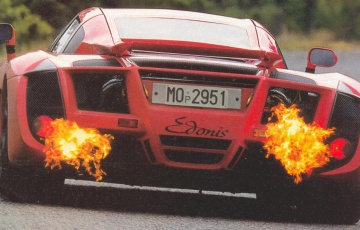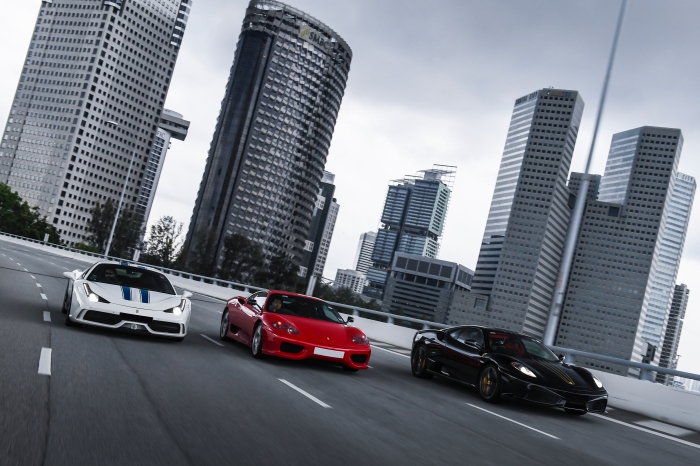

The horses are grazing quietly... but this calm can change at the drop of a hat
Singapore – At any school-day’s start/end, the immediate environs of its pick-up/drop-off points are typically a harried melee of frenzied nerves and kamikaze school-run drivers.
However, during the weekends, that same war-zone is transformed into an oasis of tranquility and becomes a pleasantly conducive place to meet... even if we’re about to shatter the calm with our storm-bringers.
(Click HERE to read about our drive of the 488 Pista)

It’s a searing Sunday, and we’ve turned the heat up even further with our steeds of choice.
I’m parked curbside, ensconced in a 458 Speciale trying to squeeze out the big chill from its air-con when I hear a strident call in the distance, a glorious melodic symphony that tickles and tantalises these jaded ears long before I spot the Rosso Corsa Challenge Stradale (CS) in the rear-view mirror as it rounds the corner.

In a way, the Challenge Stradale kickstarted the special series genre for Ferrari in modern times, probably because the brand recognised the great potential in marketing (and selling) a stripped-out road-racer adaptation of the regular production model (in this case, the 360 Modena), especially with the inevitable collectible status it could enjoy as a result of a small production run.
Unlike the special series models that would follow, the ‘360’ model designation was not used in the ‘Challenge Stradale’ nomenclature.

You could always argue that since its inception, Ferraris were race-cars first, road-cars second, and this is a trait that continues today, especially given the technology trickle-down from the brand’s involvement in various motorsports programmes.

Up to the point the CS started this special series business with the V8 mid-engined rear-drive models, Ferrari’s ultra-rarefied exotic sportscars like the F40/F50/Enzo et al were in the hands of the privileged few, with a good number relegated to garage queen status and seldom seen in the wild. It was models like the CS and its ilk that literally brought this superlative performance from the track to the road.
After all, the formula for a track-ready road-legal package is a tried-and-tested one that Porsche still uses to great effect today on its cult RS models, ever since the very first 1973/4 911 Carrera RS: lightening (of superfluous weight), sharpening (of aerodynamics and chassis) and powering-up (of engine performance).

Can't complain with a view like that!
We travel in convoy to our Dempsey rendezvous with the last car in this trilogy (and still our firm favourite), the 430 Scuderia. We follow behind the CS in the Speciale, if only to appreciate her pert derrière and lush, vibrant tone from its tail-pipes.

CHALLENGE STRADALE
I wave him forward so my eyes can drink-in every inch of the CS’s gorgeous, au naturel curves as she cruises past. It’s an achingly beautiful car created before the ‘hypebeast’ era of bodywork pumped-up on steroids and excessive aero addenda, with only the most discreet hints to appraise you of its special series status in classic wolf-in-sheep’s-clothing mold.

Compared to how its contemporaries have evolved, all of Ferrari’s special series V8s – including the latest 488 Pista HERE – continue to live up to the adage, “Speak softly and carry a big stick."




“It was love at first sight – I never knew it was a special model, but when I saw it parked in a season parking lot at the Funan Centre many years ago, my first thought was, this is how a Ferrari should look!”
GN, the 40-something owner of this pristine CS reminisces wistfully. “Although that car did come up for sale, the condition and price of this red one I eventually bought (in 08/08/08) were incomparable. The Indonesian first owner clocked 5300km over three years, and in the 10 years I’ve had her, I’ve put on just under 5000km.”

Ferrari adopts a more genteel approach to its fettling, so the entire package is more holistic than outright uncompromising, in terms of both aesthetics and driving experience.

To the casual enthusiast, it’s probably hard to imagine any Ferrari needing improvement, but the driving purist will appreciate the work that has gone into transforming a boulevard cruiser and occasional fast-road instrument into a streetable track weapon.
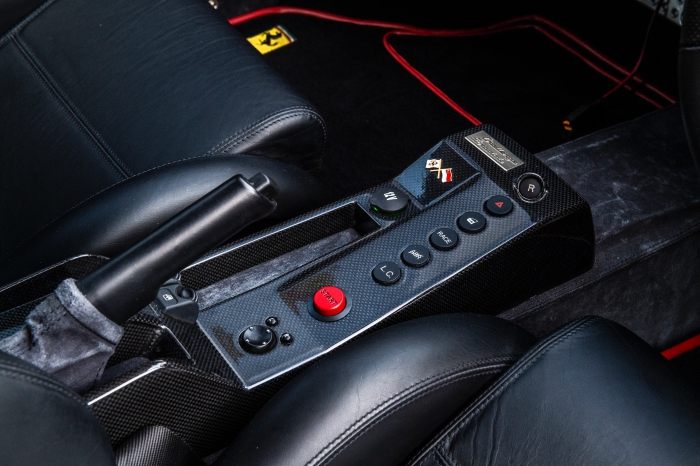
The spartan cabin is no-nonsense and all-business, as it is stripped of any insulation or carpets, with large swathes of exposed carbonfibre and Alcantara.

From CS to Pista, there’s a sense of purity and single-minded focus to the cabin that leaves no doubt as to the car’s performance abilities.
(Again, to read about our drive in the 488 Pista, click HERE)
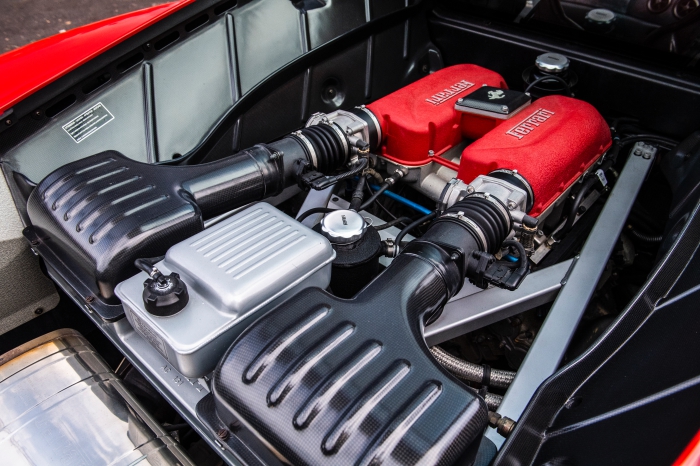
The 25bhp bump in engine output seems modest, but it’s the sum of all the parts working together and the CS’s incredible lightness of being that creates such a balanced and formidable proposition.
It’s not about outright pace or rat-race style timed runs some are so enamoured of, but about relishing the involvement of the entire driving experience.

Like the E46 M3 SMG-II transmission or Alfa’s Selespeed, a certain finesse is needed with the CS’s single-automated gearbox if you intend on making smooth progress in traffic; you can’t just keep your foot down on the gas while shifting as you would with a dual-clutch, because timed modulations of the throttle smoothen out the shifts.

Like the M3, it really comes into its own as you open up the engine on a clear road or circuit, because the gearbox thrives on high-rpm shifts, even as the engine goes positively bananas and unleashes a boisterous outburst of such aural rapture you’ll be slack-jawed gobsmacked the first time it hits you like a huge wall of sound.
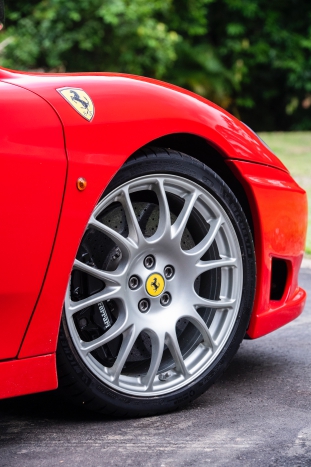
Compared to today’s instant gratification dual-clutch shifts, it’s far more gratifying to work with the CS’s 150ms shifts, because it makes you conscious of every nuance of both man and machine’s action (and reaction) when you’re pressing hard, as opposed to the get-in-and-drive, stomp-and-go character of modern sportscars.
GN agrees, “Lap times have zero significance to me, because the CS is what it is… and it isn’t a race-car.”

This wild-child isn’t a ‘safe space’ for easily-offended drivers who need their cars to flatter them soundly – if anything, the Scud will do the judging and likely be offended by your lack of ability, if that’s indeed the case.


The Speciale is often lauded as ‘collectible’ due to its status as the last nat-asp V8 special series, but our all-time favourite drive remains the Scuderia (and its drop-top 16M sibling) with its no-holds-barred blend of explosive shifts, blistering acceleration, scalpel-sharp agility and uncompromising angst.
(Click HERE to read about the 430 Scuderia's bonkers drop-top sibling, the Scuderia Spider 16M)


However, the Scud is no aimless rebel without a cause that whinges constantly when there’s work to be done and then returns half-baked results; the Scud embodies the joy of machine and is a pleasure to work hard, because it gives as good as it gets when driven hard and confidently with a committed hand at the helm.

This is no yes-man to flatter you into thinking you suddenly possess the abilities of a driving god, but is instead ready and willing to take a huge chunk out of your ego if you try to out-drive your own abilities… even at the cost of its own bodywork!

The Scud reinvents the CS’s formula and ups the ante by infusing even more raw, track-honed aggression into the package.


In case you're wondering, the 'Bumpy Road' button is the one above the hazard switch
With the Scud, Ferrari introduces the racing Manettino dial for easy toggling between drive and stability programmes, as well as a ‘bumpy road’ mode, which softens the dampers (but not otherwise affect the Race dynamic parameters) when travelling over erm, ‘bumpy roads’!

Even the Scud’s design has evolved from the sublime elegance of the CS into a bristling, aero-cheating form that brooks no nonsense from the unworthy. It’s light and agile, pushes out 503bhp/470Nm and is matched to a lightning quick F1-Superfast2 single-automated gearbox that more than halves the shift-times of the CS.

Did we mention it’s rowdily loud too? It’s not just a different beast from the CS, the Scud also boasts a soundtrack that is pure mechanical nihilistic angst.
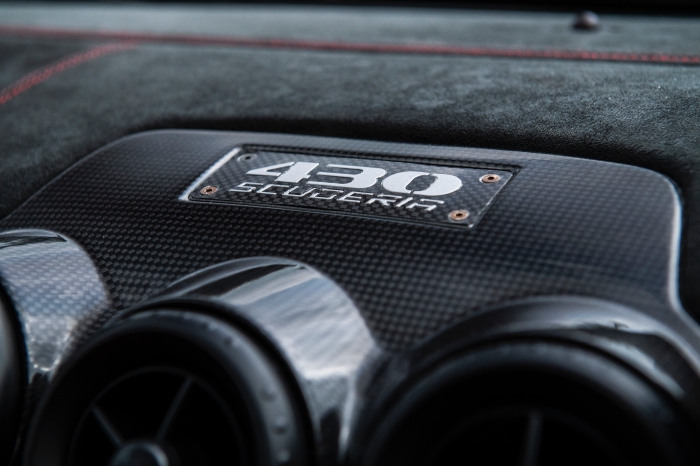

It’s easy to appreciate the Scud as the fruit of Ferrari’s engineering wizardry at its most passionate, not least because Michael Schumacher was intimately involved in the car’s development.
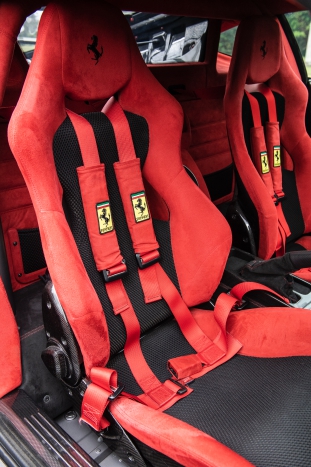
ET, the 40-something petrolhead owner of this black example thinks so too. “When you drive a Ferrari you can feel the passion; in my mind it has always been the top sportscar brand – the holy grail for any enthusiast.
Moreover, a special series like the Scuderia, with its explosive ‘shotgun-effect’ shifts always holds a special place in the heart of anyone who has driven it.”

“Every Ferrari has the ‘X’ factor and you feel special driving it knowing the history of the brand, as well as the company’s passion to design and build faster and more beautiful cars, with technology trickle-down from its F1 racing programme.
The looks, as well as the sound and sensation of driving a Ferrari gives immense satisfaction,” he adds.

Like GN, ET is unconcerned about outright lap times. “I don’t care about track times – the car must be fun, exciting, and be as analogue-feeling and light as possible for that raw driving experience.
With its performance credentials, the Scud is one of the few paddle-shift cars I will consider driving on Singapore roads (another is the CS!), as it provides fabulous involvement even when you’re not on a race-track.”

458 SPECIALE
From two owners enamoured with the analogue feel of the older models, we visit the other end of the spectrum. Some fans like to think that the best Ferrari is always the next one, or in other words, the latest.

Don’t forget, in this rarefied realm of super-sportscars, staying at the forefront of the science of speed is critical and such brands never look back, only ever forward towards the finishing line.

In addition to the familiar formula employed in the CS and Scud, the Speciale adds a new dimension of active electronic driving aids to the equation in the form of the Side Slip Angle Control (or SSC), something that has carried over into the Pista.

Also, it is the first of the special series models to feature a dual-clutch gearbox, which offers swift, seamless shifts, but otherwise leaves us cold with the absence of the Scud’s (and now Pista’s) explosive shift theatrics.
(Again, to read about our drive in the 488 Pista, click HERE)

Despite their track-ready credentials, the CS and Scud offered decidedly visceral thrills even on the road, but the technical development and go-faster credentials of the Speciale have escalated beyond that, so by the time you feel anything, you're already travelling at highly illegal speeds.


In fact, the Speciale’s owner, TS, spends a lot of time attacking the Sepang F1 Circuit and the B-roads of Malaysia, and embraces its cutting edge technology. “The Speciale doesn’t work for my transport needs in Singapore, simply because I cannot bear to drive a 596bhp, 3secs to 100km/h, sportscar in the city.”

Although he’s liked cars from a young age, it wasn’t til very recently that he made his first sportscar purchase – the Speciale. “When I started working, I didn’t have a lot of free time and was hesitant to spend money, but I realised I had my life priorities all wrong.
Things came to a head after some personal incidents and an accident in 2014 that saw me total a brand new Range Rover Vogue. I realised that life was too short and I needed to start having fun."


“Why Ferrari?” we ask. “Ferrari ticks the most boxes for me,” TS tells us, referring to his ‘pre-purchase’ checklist. “There has to be a perceived residual value, plenty of driving emotion, sufficient driving events with the owner’s club, positive road-test reviews and a racing heritage (in the expectation that race-car technology and experience are applied to the road-car).”


Like GN and ET, TS isn’t hugely impressed by record times and feels that the most important quotient about any car is that it’s fun to drive.

However, he understands that sportscars are constant works-in-progress that keep pushing the performance envelope, as well as fulfil emissions restrictions, which has led to the shift to smaller capacity turbocharged engines.
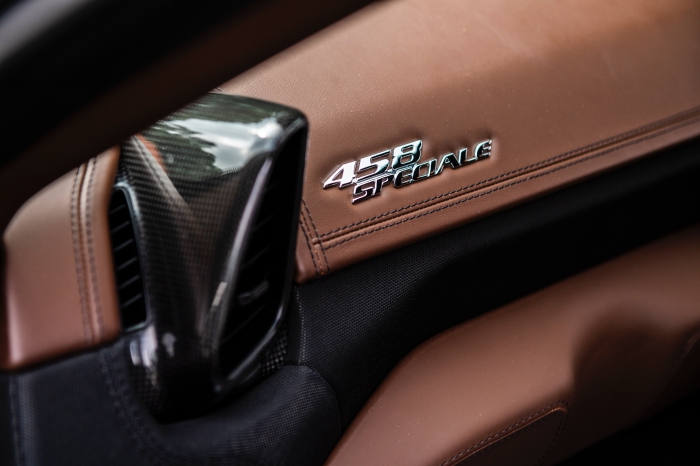
Speciale is the last nat-asp special series V8 before the 488 Pista
“We have to accept such progress and cannot live in the past…” he ruefully says. “Unfortunately, the tax structure in Singapore means we can’t keep our nat-asp dream cars, even with their tried and tested technology, for life.”
(Again, to read about our drive in the 488 Pista, click HERE)
PHOTOS Zotiq Visuals
CHALLENGE STRADALE
Engine 3586cc, V8
Power/rpm 425bhp/8500rpm
Torque/rpm 373Nm/4750rpm
Transmission 6spd F1 single-automated
0-100km/h 4.1secs
Top Speed 300km/h
Weight (dry) 1180kg
Fuel Consumption 19.1l/100km
CO2 440g/km
430 SCUDERIA
Engine 4309cc, V8
Power/rpm 503bhp/8500rpm
Torque/rpm 470Nm/5250rpm
Transmission 6spd F1-Superfast2 single-automated
0-100km/h <3.6secs
Top Speed 318km/h
Weight (dry) 1258kg
Fuel Consumption 15.7l/100km
CO2 360g/km
458 SPECIALE
Engine 4497cc, V8
Power/rpm 596bhp/9000rpm
Torque/rpm 540Nm/6000rpm
Transmission 7spd F1 dual-clutch
0-100km/h 3secs
Top Speed >325km/h
Weight (dry) 1290kg
Fuel Consumption 11.8l/100km
CO2 275g/km









